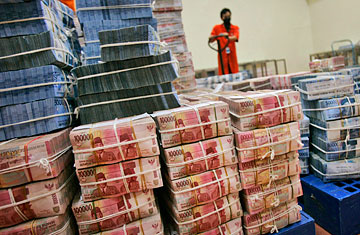
A worker sorts rupiah banknotes at the headquarters of a national bank in Jakarta, Indonesia on Oct. 10, 2008
The beleaguered U.S. dollar isn't getting much love these days, except from one small but powerful group: deep-pocketed institutional traders, who are piling into dollars with ever greater enthusiasm because it is so weak and cheap to borrow. "Dollar borrowing picked up steam after the G-20 summit {that ended in Pittsburgh on September 25} when traders concluded that interest rates in the U.S. were going to stay low for a long time," says Mark Matthews, chief Asia strategist for Fox-Pitt Kelton Securities. Adds Olivier Desbarres, a currency strategist for Asia with Credit Suisse: "Hedge funds, pension funds, and the trading desks of investment banks are now all putting this trade on."
The trade in question is known as the "dollar carry trade" because it allows traders to borrow dollars at low rates while investing in another currency that offers a significantly higher short-term yield. One factor behind its growing popularity in Asia is because the other side of the trade — the currency one buys with the dollars one cheaply borrows — are mostly to be found in the Asia-Pacific region. Most coveted, according to traders, are the Australian dollar, the Indonesian rupiah, and even the infrequently circulated Sri Lankan rupee.
Because all of these countries are growing more robustly than the U.S., their interest rates are higher, thus creating a short-term opportunity for traders. Here's how it works with a currency like the Indonesian rupiah: the six-month London Interbank Offer Rate (or LIBOR, the benchmark for U.S. dollar borrowing), is now hovering at slightly less than 1%. That rock-bottom rate stands in stark contrast to the 6.5-7% rate of interest one can get from a short-term money market bill in Indonesia, where the 5-year government bond currently yields roughly 9%. The wide gap between the carrying costs of the two currencies is what is fueling the dollar-rupiah carry trade, analysts say.
Although the rupiah could suddenly weaken against the dollar and shave off a significant chunk of a trader's profit, "If your carrying spread is wide enough, you'll comfortably take the currency risk," says Johanna Chua, chief economist with Citigroup in Asia. In fact, Chua says, the dollar carry trade has become so widespread among traders in Asia it has even triggered buying of more exotic and illiquid currencies like the Sri Lankan rupee. "That's the ultimate carry trade," Chua says.
The dollar didn't always enjoy the dubious honor of being the global currency a trader could most cheaply borrow. For much of the last decade Japan has been the world's largest moribund economy, with an economy so weak the Bank of Japan never dared to lift interest rates significantly above zero. During this time the Japanese yen was the currency traders loved. No longer, it seems. "The yen has become the least obvious carrying currency," says Credit Suisse's Desbarres, mainly because the near-zero interest rates Japan once exclusively offered are now available from central banks across the globe. Ironically, the yen today looks relatively strong compared to the dollar, making it more expensive to borrow and so riskier to carry. "Even though interest rates are low everywhere as global demand gradually picks up, we think the yen will strengthen," predicts Credit Suisse's Desbarres. Economic growth in the U.S. appears so sluggish, by contrast, that Credit Suisse does not expect any rate hikes from the U.S. Federal Reserve, necessary to strengthen the dollar, until the middle of 2010.
Until then the dollar carry trade is going to be a decidedly mixed blessing. Because the dollar is so cheaply available today it creates a source of global funding that grew dangerously scarce after the collapse of U.S. investment bank Lehman Brothers in mid-2008. That's the good news.
The bad news is that to ameliorate the worst side effects of the carry trade, which if unchecked could make Asian exports too expensive to buy, Asian central banks have intervened in foreign exchange markets and done something they are loath to do: Actually increase the dollars in their foreign reserves. "Asian central banks are accumulating even more dollars," says Credit Suisse's Desbarres. According to Citigroup, China's foreign reserves ($2.13 trillion as of June, including forward currency contracts) have increased 11.9% since the collapse of Lehman Brothers in September, 2008. Hong Kong's foreign reserves have shot up by nearly 40% over the same period. Economists point out that this new pile-up of dollars will do little to reerse a dangerous pattern of global savings and spending, wherein Asians control much of the world's cash and allow Americnas to recklessly spend it.
More important, the liquidity the dollar carry trade creates, like alcohol, can also be hazardous if taken in immoderate amounts. For instance, Citigroup's Chua says one of the reasons Asia's stock and property markets have been rallying over the last six months is because of the overabundance of short-term liquidity. "A lot of dollars are seeping into Asian economies," she says. "That's pumping up asset bubbles." When those bubbles burst, as they frequently do, there will no doubt be unpleasant messes to clean up.
